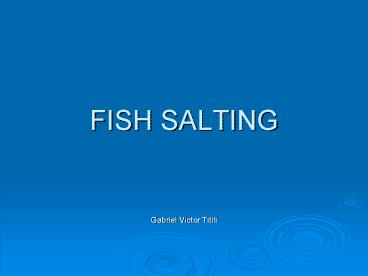FISH SALTING - PowerPoint PPT Presentation
1 / 14
Title: FISH SALTING
1
FISH SALTING
- Gabriel Victor Titili
2
SALTING
- Preservation method
- Preserves fish by lowering the moisture content
of the fish to the point where enzymatic and
bacterial activities are retarded
3
Bacterial Spoilage
- Spoilage bacteria do not survive at salt contents
above 6-8 (Brix level) - Salt remove water from the fish by OSMOSIS
- water passes from low concentration solution to
highly concentrated solution
4
Salting Process
- Water passes from the fish cells into the brine
- This continued until the level of salt in the
fish cells and the brine is of equal strength
(EQUILIBRIUM)
5
- Salting is completed when all the fish flesh
- Reached required salinity
- Acquired appropriate taste
- Consistency
- Appropriate odour
- Saturated brine solution around 26
6
Sources of Salt
- SOLAR SALT (evaporation of seawater by sun)
- Mined salt from underground salt deposits
- Dried up salt lakes
- Evaporated salt from deeply buried salt deposits
7
Salt Quality
- Chemical Composition
- 99.9 sodium chloride (NaCl)
- Free of sand, dust, mud and moisture
- Free of magnesium and calcium chlorides and
sulfates, carbonates, copper and iron - Presence of iron (gt30 ppm) and copper (gt0.5 ppm)
give rise to rancidity
8
- Microbiological quality
- Free of halophilic bacteria
- Pinking (Halophilic bacteria)
- Physical properties
- Reasonable grain size
- Fine grain salt is the best for brine salting of
fish (dissolves quickly and easily) - Larger grain salt is best fro dry salting
9
Factors influencing the salt penetration
- Fat and protein content
- Fat influence the entry of salt and withdrawal of
moisture - High protein (18-19) influence the attainment of
osmotic equilibrium
10
- Thickness of the flesh
- The thicker the fish the slower the diffusion of
salt to the center hence allow decomposition of
the center of thick muscles before salt
concentration has reached levels high enough to
prevent bacterial spoilage.
11
- Purity of the salt
- The pure the salt, the faster the salt
penetration - Impurities (e.g iron, magnesium etc.) affect the
colour and flavour of the salted product
12
- Temperature during salting
- Salt uptake is faster at higher temperatures but
the rate of bacterial spoilage is also accelerated
13
- Freshness of fish
- The fresher the fish, the more slowly salt will
be taken up
14
Method of salting
- Dry salting or Kench Process
- Wet salting

